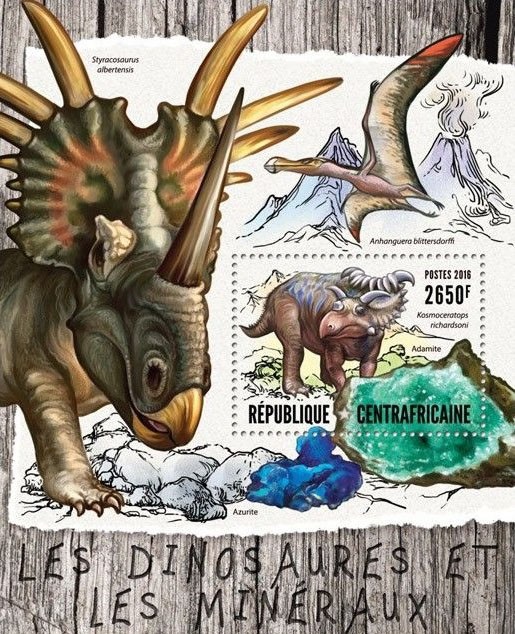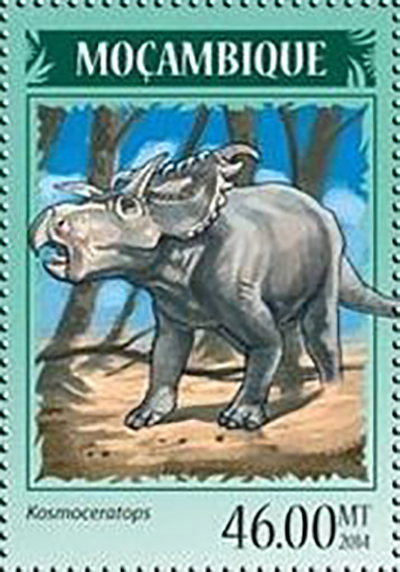Kosmoceratops richardsoni Sampson et al., 2010

Phylum: Chordata Haeckel, 1874
Subphylum: Vertebrata Cuvier, 1812
Classe: Dinosauria Owen, 1841
Ordine: Ornithischia Seeley, 1888
Famiglia: Ceratopsidae Marsh, 1890
Genere: Kosmoceratops Sampson et al., 2010
Descrizione
Questo animale possedeva il tipico aspetto dei dinosauri cornuti, ma il suo cranio era del tutto particolare. Erano presenti due lunghe corna sopraorbitali, sottili e appuntite, che si proiettavano all'infuori e curvavano verso il basso; gli altri ceratopsidi, generalmente, hanno le corna rivolte in avanti o all'indietro. Di fronte alle orbite era anche presente una sorta di protuberanza, e il corno nasale doveva essere appiattito e simile a una lama. Ma la caratteristica più sorprendente del Kosmoceratops era data dal collare osseo posteriore: era insolitamente largo, circa il doppio della lunghezza, al contrario dei suoi parenti più stretti (i casmosaurini). Lungo il bordo alto del collare erano presenti una decina di proiezioni ossee simili a uncini, otto delle quali erano ripiegate in avanti a ricoprire parzialmente il collare stesso; le altre due, laterali, curvavano all'infuori. In totale, sul cranio di questo dinosauro vi erano quindici strutture simili a corna, più che in qualsiasi altro dinosauro. Il nome Kosmoceratops deriva dal greco antico e significa "faccia ornata". Noto per alcuni resti fossili ben conservati, il Kosmoceratops è stato descritto nel 2010 ed è stato attribuito alla sottofamiglia Chasmosaurinae, nonostante le caratteristiche insolite del cranio. È molto probabile che questo animale fosse strettamente imparentato con il successivo Vagaceratops, i cui fossili sono stati ritrovati in Alberta. Insieme a molti altri casmosaurini, il kosmoceratopo abitava la Laramidia, un continente isola che attualmente forma il Nordamerica occidentale. Durante il Cretaceo superiore, la Laramidia era separata dall'Appalachia (l'attuale Nordamerica orientale) a causa di un largo braccio di mare, noto come Western Interior Seaway. In Laramidia vi fu un notevole sviluppo evolutivo di numerosi gruppi di dinosauri, e sembra che si fossero sviluppate due faune endemiche all'interno dello stesso continente isola: una in ciò che è oggi rappresentato dallo Utah e dal Colorado, l'altra nella zona a nord di questi stati. Il Kosmoceratops, insieme a molti altri casmosaurini del periodo Campaniano (come Utahceratops), visse nella parte meridionale, mentre la provincia settentrionale era abitata dalle specie di Chasmosaurus. Quando le due provincie si riunirono, nel giro di pochi milioni di anni il Kosmoceratops e i suoi parenti migrarono verso nord, dando origine a forme come Vagaceratops. È possibile che, in seguito, furono proprio questi animali a dare origine ai casmosaurini più specializzati, come il Triceratops.
Diffusione
Era un dinosauro erbivoro appartenente ai ceratopsidi, o dinosauri cornuti. Visse nel Cretaceo superiore (Campaniano, circa 76 milioni di anni fa) e i suoi resti fossili sono stati ritrovati in Nordamerica (Utah).
Bibliografia
–"Amazing horned dinosaurs unearthed on "lost continent"". University of Utah News. 2010.
–Sampson, S. D.; Loewen, M. A.; Farke, A. A.; Roberts, E. M.; Forster, C. A.; Smith, J. A.; Titus, A. L.; Stepanova, A. (2010). "New horned dinosaurs from Utah provide evidence for intracontinental dinosaur endemism".
–Loewen, M.; Farke, A. A.; Sampson, S. D.; Getty, M. A.; Lund, E. K.; O’Connor, P. M. (2013). "Ceratopsid dinosaurs from the Grand Staircase of Southern Utah". In Titus, A.; Loewen, M. (eds.). At the Top of the Grand Staircase: The Late Cretaceous of Southern Utah. Bloomington: Indiana University Press. pp. 488-503.
–Getty, M. A.; Loewen, M. A.; Roberts, E.; Titus, A. L.; Sampson, S. D. (2010), "Taphonomy of horned dinosaurs (Ornithischia: Ceratopsidae) from the late Campanian Kaiparowits Formation, Grand Staircase – Escalante National Monument, Utah", in Ryan, M. J.; Chinnery-Allgeier, B. J.; Eberth, D. A. (eds.), New Perspectives on Horned Dinosaurs: The Royal Tyrrell Museum Ceratopsian Symposium, Bloomington: Indiana University Press, pp. 478-494.
–Lund, Eric K.; Sampson, Scott D.; Loewen, Mark A. (2016). "Nasutoceratops titusi (Ornithischia, Ceratopsidae), a basal centrosaurine ceratopsid from the Kaiparowits Formation, southern Utah". Journal of Vertebrate Paleontology. 36 (2): e1054936.
–Sampson, S. D. (2012). "Dinosaurs of the lost continent". Scientific American. 306 (3): 40-47.
–Longrich, N. R. (2014). "The horned dinosaurs Pentaceratops and Kosmoceratops from the upper Campanian of Alberta and implications for dinosaur biogeography". Cretaceous Research. 51: 292-308.
–Levitt, C. G. (2013). Bone histology and growth of chasmosaurine ceratopsid dinosaurs from the late Campanian Kaiparowits Formation, Southern Utah (Thesis). University of Utah. Archived from the original on July 14, 2017. Retrieved June 25, 2019.
–Dodson, P. (2013). "Ceratopsia increase: history and trends". Canadian Journal of Earth Sciences. 50 (3): 294-305.
–Gonzales, R.; Siegler, K.; Dwyer, C. (2017). "Trump orders largest national monument reduction In U.S. history". NPR.org.
–Finnegan, M. (2017). "Remarkable dinosaur discoveries under threat with Trump plan to shrink national monument in Utah, scientists say". Los Angeles Times.
–Panciroli, E. (2017). "Why are palaeontologists suing Trump?". The Guardian.
–Wei-Haas, M. (2017). "What shrinking fossil-rich national monuments means for science". Smithsonian Magazine.
–Gramling, C. (2017). "Science and politics collide over Bears Ears and other national monuments". Science.
–"The Wilderness Society et al.v. Trump et al. (Grand Staircase–Escalante)". NRDC. April 10, 2020.
–Longrich, N. R. (2015). "Systematics of Chasmosaurus – new information from the Peabody Museum skull, and the use of phylogenetic analysis for dinosaur alpha taxonomy".
– Campbell, J. A.; Ryan, M. J.; Holmes, R. B.; Schröder-Adams, C. J.; Mihlbachler, M. C. (2016). "A re-evaluation of the chasmosaurine ceratopsid genus Chasmosaurus (Dinosauria: Ornithischia) from the Upper Cretaceous (Campanian) Dinosaur Park Formation of Western Canada".
–Fowler, D. W.; Freedman Fowler, E. A. (2020). "Transitional evolutionary forms in chasmosaurine ceratopsid dinosaurs: evidence from the Campanian of New Mexico". PeerJ. 8: e9251.
–Paul, G. S. (2016). The Princeton Field Guide to Dinosaurs (2 ed.). Princeton: Princeton University Press. pp. 285-286, 296.
–Fowler, D. W.; Freedman Fowler, E. A. (2020). "Transitional evolutionary forms in chasmosaurine ceratopsid dinosaurs: evidence from the Campanian of New Mexico". PeerJ. 8: e9251.
–Mallon, J. C.; Holmes, R.; Eberth, D. A.; Ryan, M. J.; Anderson, J. S. (2011). "Variation in the skull of Anchiceratops (Dinosauria, Ceratopsidae) from the Horseshoe Canyon Formation (Upper Cretaceous) of Alberta". Journal of Vertebrate Paleontology. 31 (5): 1047-1071.
–Wick, S. L.; Lehman, T. M. (2013). "A new ceratopsian dinosaur from the Javelina Formation (Maastrichtian) of West Texas and implications for chasmosaurine phylogeny". Naturwissenschaften. 100 (7): 667-682.
–Longrich, N. R. (2011). "Titanoceratops ouranos, a giant horned dinosaur from the late Campanian of New Mexico". Cretaceous Research. 32 (3): 264-276.
–Campbell, J. A. (2014). A re-evaluation of the chasmosaurine ceratopsid Chasmosaurus (Dinosauria: Ornithischia) from the Upper Cretaceous (Campanian) Dinosaur Park Formation of Western Canada (Thesis). Carleton University.
–Campbell, J. A.; Ryan, M. J.; Schröder-Adams, C. J.; Holmes, R. B.; Evans, D. C. (2019). "Temporal range extension and evolution of the chasmosaurine ceratopsid 'Vagaceratops' irvinensis (Dinosauria: Ornithischia) in the Upper Cretaceous (Campanian) Dinosaur Park Formation of Alberta". Vertebrate Anatomy Morphology Palaeontology. 7: 83-100.

|
Data: 18/07/2016
Emissione: I dinosauri e i minerali Stato: Central African Republic |
|---|

|
Data: 30/04/2014
Emissione: Dinosauri Stato: Mozambique Nota: Emesso in un foglietto di 4 v. diversi |
|---|